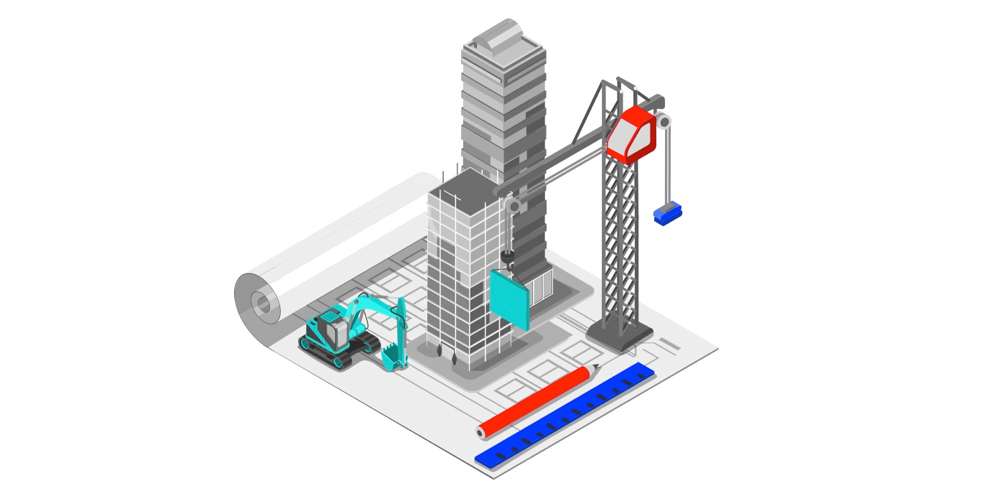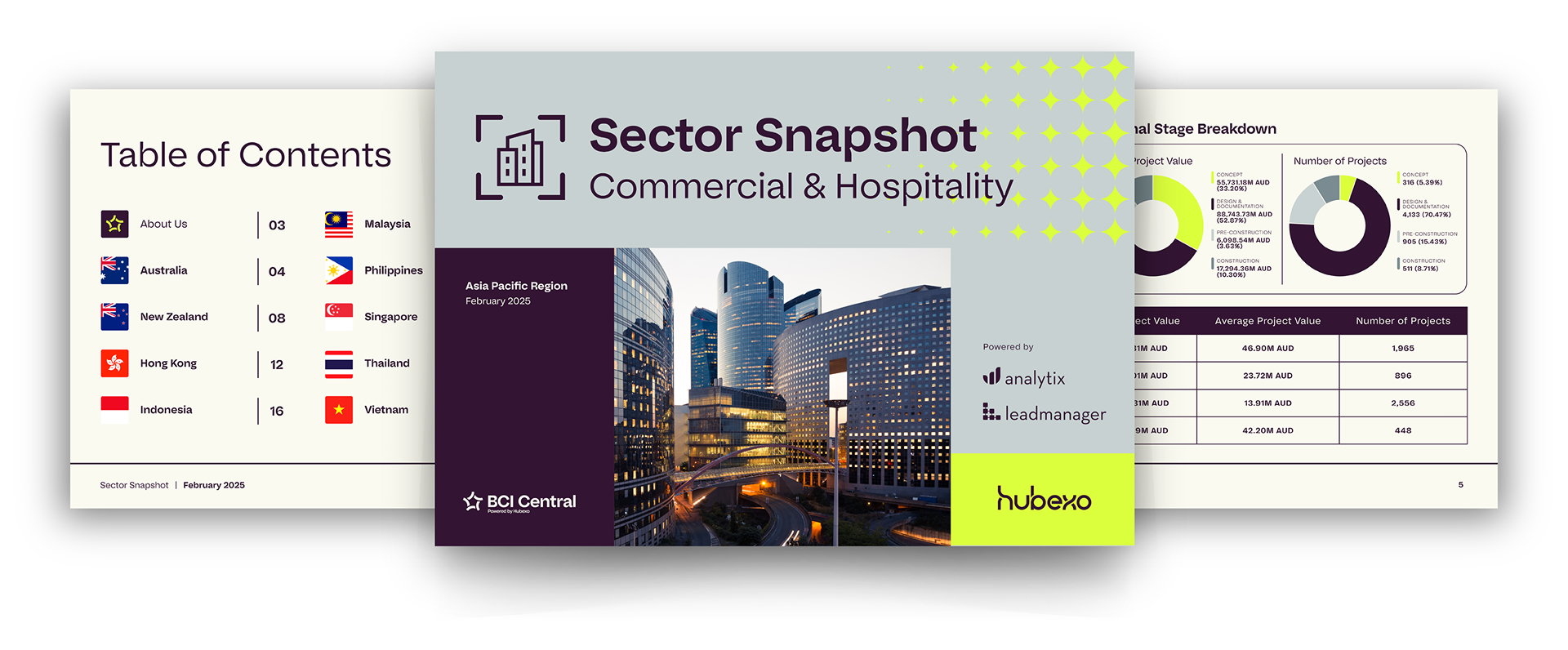- Home
- >
- The 4 Key Construction Project Stages in Singapore
The 4 Key Construction Project Stages in Singapore

LeadManager is purpose built for the construction, mining and architectural sales environment. Our platform offers comprehensive details across the key milestones in establishing a project, broken down into four stages: Concept, Design & Documentation, Pre-Construction and Construction.
We examine the key details of the project stages below—specifically for projects in Singapore—complete with a brief overview of what each stage includes.
Concept
- Design Tender/Competition
- Design Contract Awarded/Competition Winner
- Early Planning
- Rezoning
- Deferred
- Abandoned
Before any project can commence, a basic outline or concept must be established. During this early planning stage, a feasibility study may be conducted. This is where the developer looks at the financial viability and demand in the area for their project.
For smaller projects, feasibility might be quite informal. For larger projects, and those involving government departments, a formal feasibility study may be required.
Formal feasibility studies examine the potential of the proposed development. Studies may include environmental assessments and assess any effects on existing heritage values for the community—there is usually a community consultation period.
As part of Singapore’s development master plan, land or redevelopment sites are sold with specific guidelines about what can be developed in that area. Whether the project be for industrial, residential or commercial use, it has to meet the pre-approved zoning of the land. In this way, any decision to rezone land is also at the government’s discretion.
Concept: Summary
- Proposing the project
- Evaluating the business model
- Deciding whether to proceed
- Appointing designers, consultants and engineers
Design & Documentation
- Plans In Progress
- Design Application
- Design Approval
- Documentation In Progress
- Building Application
- Building Approval
- Site For Sale
- Deferred
- Abandoned
Once an architect or designer has been appointed, sketch plans can commence. Sketch plans are early drawings that help define the scope of the project as well as pave the way for submitting a design application or development application.
An outline application, submitted to the Urban Redevelopment Authority (URA), offers a broad project proposal. It identifies points such as the proposed land use, plot ratios or building heights, and paves the way for the developer to submit a formal application.
Written permission is a formal development application that outlines the specific design and scope of the intended project—it is also submitted to the URA for approval. If any changes are made to the original project design or scope, a new WP must be submitted.
Documentation In Progress refers to the detailed designs that are usually undertaken after the written permission has been approved. These designs are the blueprints for the project and are commonly completed by an architect, engineer or the builder. These documents will be used for the tender process and to submit a building plan and structural plan application.
Building plan and structural plan applications are submitted to the Building Construction Authority (BCA) of Singapore through a qualified person (QP)—an individual who is registered as an Architect with the Board of Architects (BOA), or as a Professional Engineer with the Professional Engineers Board (PEB). Once these applications have been approved, a permit to commence construction works must be obtained from the BCA.
Design & Documentation: Summary
- Defining how projects fit into the local area
- Defining exterior characteristics and specifying exterior products
- Submitting plans for approval and gaining approval
- In-depth planning and drafting of architectural drawings or schemes
- Specification of products to be used internally
- Engaging consultants and engineers
- Preparation of tender documentation
Pre-Construction
- Expressions Of Interest
- Tender Called
- Tender Called (Tenderers Listed)
- Tender Closed
- Tender Closed (Tenderers Listed)
- Contract Awarded/Builder Appointed
- Deferred
- Abandoned
The main contractor can be appointed at any stage of a project; they can also be appointed in a number of different ways.
Many projects, particularly government-funded developments, require builders to be selected via the tender process. This can happen at almost any stage of the development process, but it most commonly occurs after design approval has been granted and when more detailed documentation has begun. Potential builders, or contractors, are notified or invited to tender for the contract to build.
Once the tender is invited, a set time is allocated for the decision process to take place. This is commonly two to four weeks, but it can take several months on some projects.
Some common contract types include:
- Open tender: The tender is openly advertised to all building or contracting firms to lodge a bid.
- Select tender: A select few building or contracting firms are invited to submit a tender bid. An expression of interest (EOI) or registration of interest (ROI) may be extended beforehand. These exclusive opportunities are often used for commercial projects where the tender schedule is not disclosed.
- Prequalified tender: More specific government tenders often require the builder to be prequalified to a certain capability level before they can be considered for tendering. In most cases, the building or contracting firms need to be registered with the government. Prequalified tenders may be specified as open or
- Negotiated contracts: The development team may already have one or two builders in mind for a project based on the builder’s reputation or an existing relationship from previous projects. The developer will negotiate cost, timeframe, special conditions, and, once agreed, will sign contracts to appoint the builder of choice.
Other contract types include design-and-construct; engineering, procurement and construction (EPC); and develop-and-build, which is an informal contract type that is used by BCI for projects where the company developing the project is also building.
Pre-Construction: Summary
- Advertising for contractors to submit a bid/proposal
- Contractors source pricing for specified products, labour, or services
- Shortlisting preferred contractors
- Evaluating contractors based on price, quality, experience, timeframe and choice of subcontractors
- Awarding main contract
Construction
- Main Contractor On Site
- Site Works Commenced
- Construction Commenced
- Deferred
- Abandoned
- Subcontractor Tender Called
- Subcontractor Tender Closed
- Subcontractor Tenderers Listed
- Subcontractor(s) Appointed
- Subcontractor Tender Deferred
- Subcontractor Tender Abandoned
Main Contractor On Site refers to when the main contractor, rather than a subcontractor, is undertaking the forward/civil/site works. A project is reported as Main Contractor On Site if the forward works will take longer than four weeks; if the works will take less than four weeks, then the project will be reported as Construction Commenced.
When a subcontractor carries out the early works, the project is reported as Site Works Commenced. These forward works often involve demolition, clearing and grubbing, piling and boring, foundation works and site remediation. A project is then reported as Construction Commenced once the concrete slab is being laid or the foundation is being established.
Construction: Summary
- Selecting trades/subcontractors
- Establishing site presence/commencing early and enabling works
- Commencing building works
- Managing construction budgets and timeframes
Contact us today for more information on how LeadManager can help your business.






